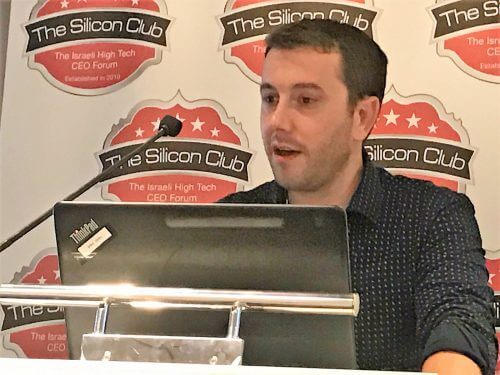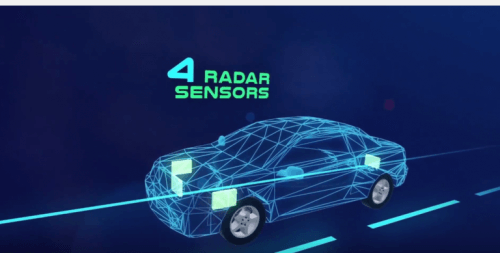Says Dr. Noam Arkind, CEO of Arba Robotics, which develops radar for autonomous cars

Dr. Noam Arkind, CEO of Arba Robotics at the Silicon Club meeting. Photo: Ayelet Gerdman
Vehicles will look very different in the next 15 years. This is what Dr. Noam Arkind, CEO of Arba Robotics, said at the Silicon Club meeting that took place on September 18, 2018, and dealt with technologies that will change our lives in the coming decade. Arba Robotics is developing a high-resolution radar that will increase the car's level of autonomy.
According to Dr. Arkind, Arba Robotics which started as a robotics company decided to focus on one, but important type of robots - autonomous cars. The company is developing a high-performance radar that will allow the car to make decisions on its own.
The vehicles keep changing. Soon we will see many more electric cars on the roads, for example China announced that by 2020 all cars will be replaced by electric cars. Another change is that the vehicles will talk to each other and to the environment, and this will have an impact on both the automotive industry and the infrastructures. This dependence also brings with it cyber risk.
Also, if the vehicles make the decisions on their own to the point that they end up driving on their own, there will be no point in everyone owning a car for themselves. We will see more car sharing. Therefore, the first autonomous vehicles are minibuses that rotate in a fixed line - autonomous shuttles. The projects today are still closed and expensive, they require an entire server farm in the trunk. The vehicles will be surrounded by sensors on all sides, and the decision-making system checks their data and changes the decisions accordingly.
"The expensive price means that new functions such as autonomous driving in traffic or safety features will first reach the luxury cars and only then will they reach the more popular cars. Also safety regulations of the automobile industry, such as NCAP, push forward the issue of sensing and the ability to make decisions. The cars will be safer even in the next two or three years. You don't have to be a futurist to see that all the technologies needed for the development of autonomous cars will be ready soon, the question is how the public will accept this technology."
Apart from public concern, there are still problems preventing this market from exploding. The first is how mature the technology is both in terms of reliability and cost. The sensors used in autonomous vehicles today are very expensive. Lots of sensors on the roof, and very large and expensive processing power, and they are also not at a high level of reliability, and as we have seen with Tesla and Uber, they may cause accidents.
According to Dr. Arkind, there are already car radars today, but their resolution is still low. Radar is already very helpful for cruising and automatic stopping, but not yet at a level that would be sufficient for an autonomous vehicle. The radar has many advantages, it is resistant to harsh environmental conditions such as fog, rain, snow, and dust, and it is able to detect objects on the road from a great distance, even through the car in front of it. "For example, if there are two vehicles (in the example he showed a private car and a motorcycle) traveling side by side, they may be considered by the car's computer as one object, so we also use the ability to separate targets using Doppler. If two targets move at even slightly different speeds, you can separate them."

accident prevention
"The Tesla and Uber accidents, the ones caused by the vehicles, happened because of sensing problems. Even when the sensors saw the target, they failed to recognize that it was a dangerous target, such as when the Tesla car hit a parked fire engine. The ability to separate the targets is not good. If a person was standing next to the truck there would be no chance of seeing him."
"In the end, there will be several radars on the vehicle, some of which will produce an image of a narrow field of view with reasonable resolution, and others a wide field of view with low resolution. The radar we are developing will provide a four-dimensional image - and will allow the car's computer to make decisions that take into account a wide field of view."
"The radars that exist today do not know how to detect height, and may cause a car to stop because of a Coke can on the road. The way our radar is designed, it will be able to detect height differences. It will give the car an indication of what is happening around it with a resolution of thousands of pixels. This is sufficient resolution to allow an autonomous car to make decisions.”
The radar devices we develop see millimeter waves, and we make it possible to receive a large number of channels in a small silicon volume. The processor is able to process 72 radar images simultaneously. We operate one car for tests, and know, for example, the shape of the guardrails on the side of the road - only with the help of RF (radio) waves, to identify where each object is and its speed, and to separate the objects even when they are crowded.
Now we are also working at the same time on combining the radar indication with information from a camera. When we have both a high-resolution radar and a camera - we have all the necessary details to make decisions about overtaking and stopping.
"Arba Robotics employs about sixty people, has registered around ten patents, so far we have raised 23 million dollars, we have developed three chips that are in the test car. We are in contact with all the car companies, competing in the tenders of global car companies. At some point in the near future we will freeze the situation and move to production."
More of the topic in Hayadan:

4 תגובות
No. Because as you can read there are other reports from that conference and no one paid me.
Isn't the inscription "advertising section" missing?
Without prejudice, the article is a kind of summary of previous articles and is suitable for a site like ynrt.
There is no innovation or science here.. Casual
"The radar we are developing will give a four-dimensional image"
What is the fourth dimension? It seems to me more impressive than the whole project